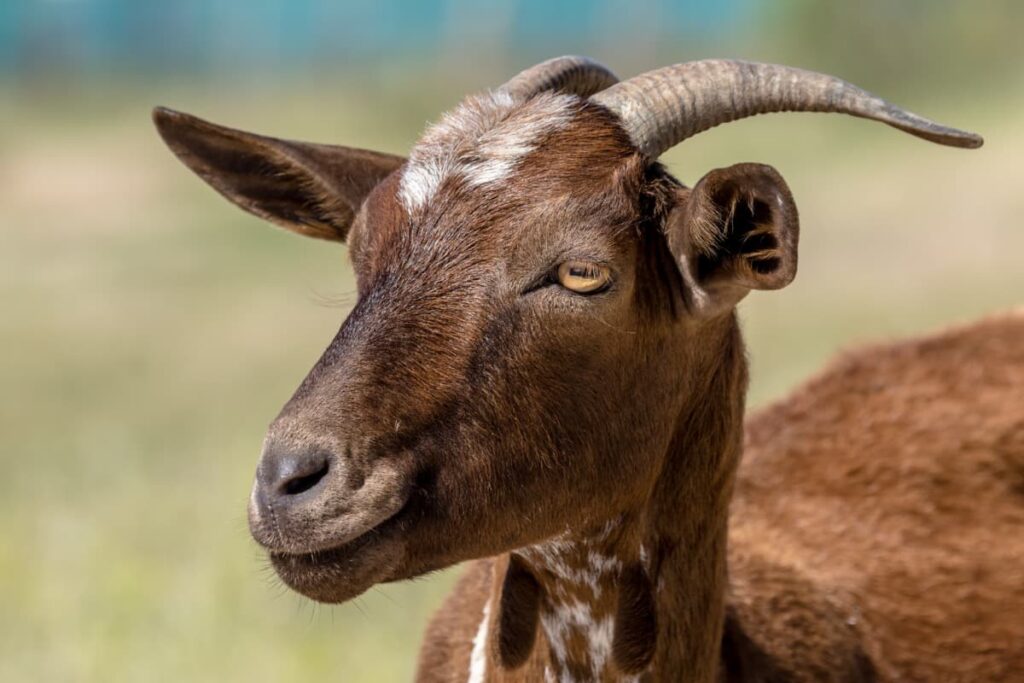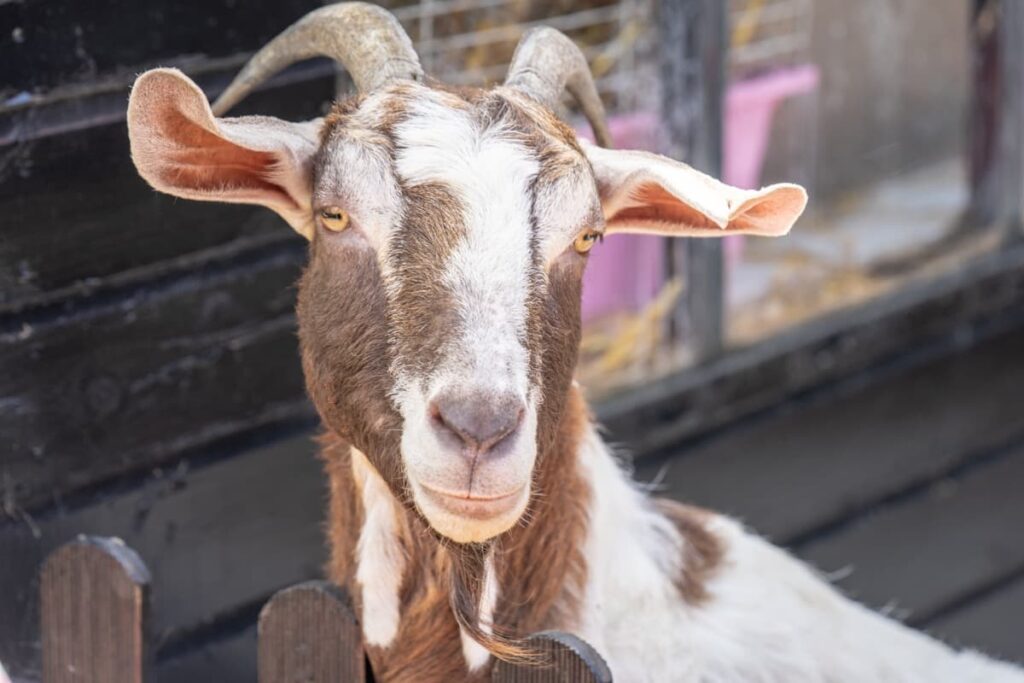Khari goat farming has great potential in Nepal due to its high demand for meat consumption across the country. With proper housing facilities, fencing requirements, feeding practices, and healthcare management, this goat breed could be profitable for farmers who raise them commercially or domestically. Their popularity in Nepal can be attributed to their hardiness, meat quality, and ease of management.

Facts About Khari Goat Breed
- Breed Name – Khari
- Breed Purpose – Meat
- Breed Size – Small
- Weight – Buck – Vary from 28 to 40 kg, Doe – About 24 kg
- Horns – Yes
- Climate Tolerance – All Climates
- Coat Color – Many
- Country/Place of Origin – Nepal
Characteristics of the Khari Goat Breed
- Khari goats are a popular goat breed in Nepal. These goats have distinct physical characteristics that set them apart from other breeds. They have medium-sized bodies with short hair and come in various colors, such as black, white, and brown.
- They can survive extreme weather conditions, including hot summers and cold winters.
- Moreover, these goats are mainly raised for meat production due to their high-quality meat yield. The demand for Khari goat meat is steadily increasing both domestically and internationally.
- The Khari goat’s distinctive physical features and resilience make it an excellent choice for farmers who want to start a profitable goat farming operation.
Khari Goat Weight
The females weigh around 24 kg while males can range from 28 to 40 kg. To ensure that your Khari goats reach optimal weight, providing them with a balanced diet rich in protein and fiber is important. Feeding practices should be tailored to each goat’s needs based on gender, age, and activity level.
Why Khari Is So Popular Breed of Goat in Nepal?
- This breed’s popularity can be attributed to several factors that make it an ideal choice for small-scale farming operations in Nepal.
- Moreover, these goats exhibit exceptional disease resistance compared to other breeds. As a result, farmers enjoy lower veterinary expenses and reduced risks associated with illness among their livestock population.
- Another reason behind Khari goats’ widespread appeal is their efficient feed conversion rate. They can gain weight rapidly while consuming relatively small amounts of fodder compared to other meat-producing animals, making them perfect for resource-limited environments like Nepal.
Housing and Fencing Requirements for Khari Goats
- Khari goats are hardy and adaptable creatures that can thrive in diverse environmental conditions. However, adequate shelter and fencing are essential for their safety and well-being.
- The primary consideration for goat housing is providing a comfortable living space that protects them from harsh weather conditions.
- The house size should be proportionate to the number of goats you intend to keep. Ensure enough feeding troughs, sleeping areas, and water sources are available for each animal.
- Fencing protects your Khari goats from predators such as dogs or wild animals. The fence should be at least 4 feet high and strong enough not to break down easily when pushed by larger animals.
- Properly maintained fencing will help keep your Khari goats safe while giving them plenty of room to roam freely inside their enclosure.
Factors to Consider Before Starting Khari Goat Farming
- Success is important to assess the market demand for the breed in your area. Conducting thorough research on potential buyers and their requirements can help you tailor your farm’s products accordingly.
- Another crucial factor is land availability and its suitability for raising goats. The land should have adequate space for grazing, shelter construction, and access to clean water sources.
- The availability of finance or capital investment is another key consideration when starting Khari goat farming. One may need funds to purchase initial stock, build housing units and cover operational costs before generating profits from sales.
- Additionally, knowledge of basic principles of animal husbandry, such as feeding practices, health care requirements, and breeding techniques, is necessary for successful goat farming. It is advisable to seek mentorship or training from experienced farmers before diving into this venture.
In case you missed it: Exploring the Art of Goat Farming in Kashmir Valley

Best Tips for Raising Khari Goats
- Provide adequate housing: It is essential to provide a clean, dry, and well-ventilated shelter for your Khari goats. The house should have enough space to accommodate all the animals comfortably.
- Maintain good hygiene: Regular barns or shed cleaning will free your animals from diseases like mange or worms.
- Feed them nutritious food: A balanced diet of hay, grains, and minerals ensures that your Khari goat maintains optimal health.
- Give access to fresh water: Always ensure that plenty of clean water is always available for your Khari goats.
- Monitor their health regularly: Conduct regular check-ups on your animals’ overall health status by observing physical signs such as weight loss or lack of appetite.
Feeding Practices for Khari Goats
Feeding Khari goats is relatively easy as they are non-fussy eaters. However, their diet should be balanced and meet their nutritional requirements to ensure healthy growth. Khari goats thrive on a diet consisting of both grass and browse. Aside from grazing and browsing natural vegetation in the pastureland where they are raised, providing them with hay is essential during winter when food sources are scarce. A mix of alfalfa hay and other varieties such as oat or timothy will give them nutritional value to maintain good health throughout the year.
It’s also important to supplement their diet with grains for additional protein intake, which helps stimulate growth rates in young kids while keeping adult animals strong. Furthermore, fresh water must always be available at all times for Khari goats, regardless of age or gender, since dehydration can lead to serious health problems which could harm your livestock if not addressed immediately.
Health Care Requirements for Khari Goats
- Vaccinations: Ensure timely vaccinations of your Khari goats against common diseases like pneumonia, tetanus, and foot and mouth disease.
- Deworming: Regularly deworm your goats, as internal parasites can cause serious health issues.
- Hoof care: Proper hoof trimming and routine check-ups can prevent lameness in your herd.
- Cleanliness: Maintain a clean and hygienic environment for your goats to avoid infections.
- Nutrition: Provide a balanced diet with enough minerals, vitamins, proteins, carbohydrates, and fiber to keep them healthy.
In case you missed it: Jamunapari Goat Breed: A Comprehensive Information Guide

Conclusion
Khari goat farming has become popular in Nepal due to its numerous advantages. Khari goats are highly adaptable and can thrive even under harsh weather conditions. This makes them perfect for farmers living in areas with extreme temperatures. Khari goats are highly resistant to diseases, which means less veterinary care and lower costs for farmers. They also mature early and reproduce quickly, making them an ideal meat production breed.
- Types of Grass Growing for Goat Farm
- How to Train Goats for Milking: A Beginners Guide
- Goat Milking Practices and Equipment: A Beginner’s Guide
- Goat Farming for Fiber: Producing Mohair and Cashmere
- Maximizing Goat Milk Production: Tips for Dairy Goat Farmers
- Goat Farming as a Family Business: Strategies for Success
- Profitable Kenya Goat Breeds for Commercial Dairy and Meat Business
- Unlock the Secrets of Oberhasli Goat: Discover Raising and Management Practices
- Ultimate Guide to Myotonic Goats: Explore Profile to Raising